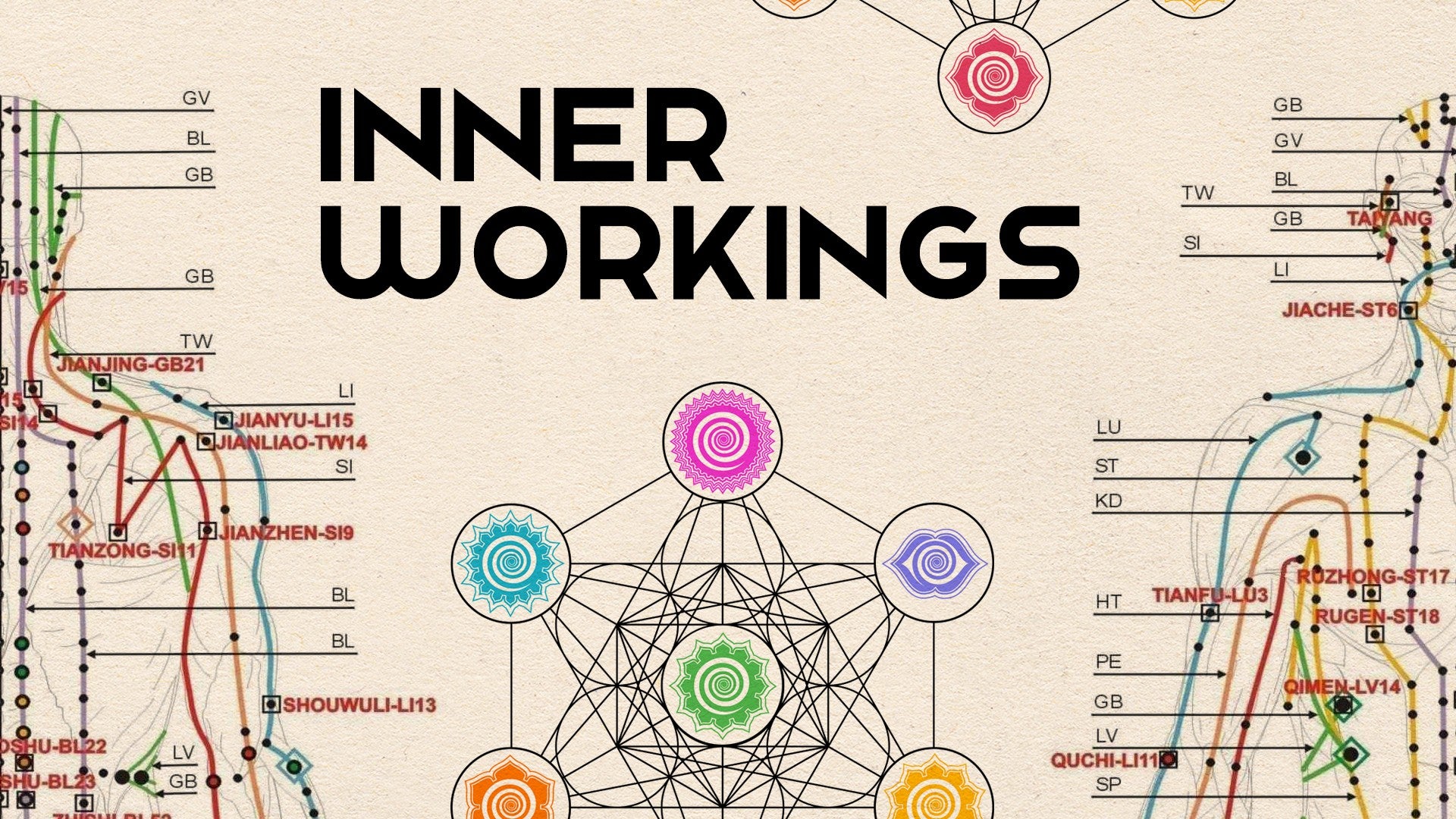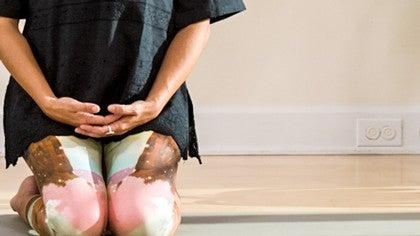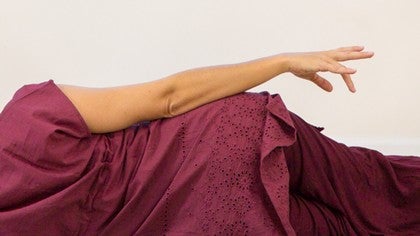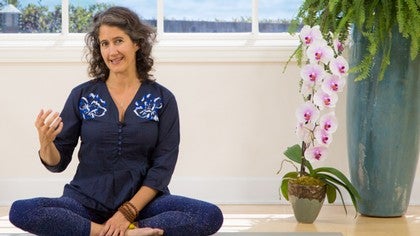Description
About This Video
Transcript
Read Full Transcript
(ocean waves breaking) So, according to the yogis, the hands are direct extensions of our hearts. Many of the subtle channels which our Daoist friends refer to as meridians, but our yogi friends refer to as nanis. Many of the subtle channels of the heart are believed to move directly out into the hands. These are one of the ways we do our work in the world. And so, starting to understand what you're hands are doing as a way to start to understand what's in our hearts.
So today, what we'll play with is we'll play with just a simple sequence to tune our attention and our awareness here and we'll play with two very, very simple mudras, mudra means seal. And so we'll be playing with just particular positions of the hands. Now, the hope here is that we can move into the mode of being a yogi scientist. So often, it's tempting to know in advance what the effect of the mudra is going to be before doing it. The play here is to see if we can tune in enough and actually experience the effect for ourselves.
Now, what makes this really interesting is that after doing your own experimentation, you let us know, because as yogi scientists, we're interested in collecting the data and if you don't tell us how it went, we won't be able to know. Okay, so you'll want something to be able to sit on for our final meditation. I'm gonna be using two blankets, you might have a different set-up. What we'll do, the way we'll start, is while lying down in one of my favorite positions, that I have to give a shout-out to our friend Papa Schiffman for. Now, I'm gonna lie down with my back to you so that you can see what I'm doing with my arm.
But don't worry, we're still connected. Okay. So you lie down on, maybe you have a yoga mat, if you have a yoga mat, lie down on the far edge so you'll have plenty of yoga mat behind you. If you're at home on your comfy rug, it's not as important. So, when you lie down in reclining Buddha, both knees are bent, okay?
Now, this hand which is supporting my head, this hand could be bent like this or it could be straight. It just depends on what's more comfortable for you. I like to bend it, and also, I think it'll help the sound on this microphone. So, keeping the knees bent, keeping this hand supported, this hand wants to find her way gracefully, draped down over your side body. Okay, now this position, reclining Buddha, and so, every sculpture of the Buddha I've ever seen, the belly and the face are quite gentle and soft.
So here, step one, maybe a deliberate inhale, maybe exhale everything. And as you soften your belly, as you soften your belly, can you notice the effect on your face? And then, every sculpture of the Buddha I've had the privilege of seeing, the hands are quite considered, so this hand that's up on this top hip can you allow her to feel more graceful? Just tune into her feeling more graceful. And the quality that we're tuning towards, the quality is, one of the ways of defining it is santosha, or ease with the way things are.
So soft in the belly, soft in the face, graceful in the hand. And then, the next step is that we're gonna floss the shoulder a little bit, which is why I bothered to turn away from you, my friends. Reach your right, your top arm up. Soften the elbow a little bit so the shoulder plunks down into socket and then just begin to floss the shoulder a little bit. So, as you exhale, you'll rotate the shoulder forward and as you inhale, you'll rotate the shoulder back.
Okay, as you you exhale, you'll rotate the shoulder forward and as you inhale, you'll rotate the shoulder back. And just do this a few times, you're just kinda flossing that joint a little bit, very similar to what we often do in the hip joints and just kinda let the elbow and the hand follow. And while I've just started to show you doing this, you might be inclined to stretch the arm over the top of the head. Okay, but you just wanna get a little bit of juiciness in there. Eventually, you're gonna rotate the shoulder forward, bend the elbow, and you're gonna bring the hand behind you, palm facing away.
Now, keeping the hand near the sacrum is a really sweet way to start as you depress this top shoulder away from the ear. Let's make sure you can see that a little bit more clearly. Depress that shoulder away, send this elbow forward towards the navel side, and this might be spicy enough. Some of you might be inclined to snuggle this hand a little higher up your back. Okay, you'll know in a moment though, whether or not that was a good idea, because once you have the hand where you believe it should be, you're gonna gently roll onto your back and you're gonna pin this hand underneath you, okay?
Now, big deliberate inhale, exhale everything, let a bit of a (loud sigh) happen. And now the play here, with that hand pinned underneath you, if it's too much, definitely snuggle it down a little bit or readjust. But the play here is, most likely, you can feel an opportunity in this shoulder. So on me, this is my right shoulder, on you it might be a different one. (laughing) Soft.
And the play here is, can I remember that same quality of santosha, so even though what I'm feeling in the shoulder might be quite intense, can I soften the belly, can I soften the heart, can I let the lips be fluffy, eyes kind? Now again, the problem is I don't seem to be able, yogis talk about the hands as extensions of the heart, but for me, they're extensions of the mouth. I can't seem to talk without them. (laughing) My friend Kristen, who works with me here at Yoga Anytime, tells me that this ends up looking like a little hand puppet. Just too funny.
Okay, so let a bit of a (loud sigh) happen. So what we're doing by holding this hand behind the back in a relaxed state for a slightly extended period of time, we're hoping to affect the connective tissue. Now, they used to believe that it took ten minutes to affect the connective tissue. Thank goodness our friends at University of North Carolina, word, found out it really only takes about 90 seconds, so grateful. I don't have a clock in front of me, so I'm imagining that we're gonna be here about two minutes or so, but I could be way off.
If you hadn't noticed, I tend to be so slow. (laughing) Alright, not much longer, soften the shoulder blade, let that arm get heavy, last few beats. Okay. Now, the dismount looks like this. You're gonna roll away from that hand, okay?
You're gonna free that arm and then you're gonna rest, both hands down along your side, palms turned up. Okay, big deliberate inhale, exhale everything, and then just really be attentive of how this feels. Like, how does it feel down through the arm you were just attending to into the palm? Can you be more aware of the flow of you? And sometimes what we like to do around here is, what we find helpful is, while you could just simply rest in the experience and that's quite awesome.
It can sometimes be helpful to... Essentially, can you see what the arm now feels like or do you have some words to describe it? Is it tingly, bright, flowy, sparkly? One woman once described it as feeling like a ripe avocado. Love that.
Okay, this is where the poetry comes from. Okay nice, now this is where you're grateful that your Hindu goddess-ness isn't showing, because otherwise, we would have seven more sides if you had eight arms. So the only, still have second side. So come on to reclining Buddha, like towards the front of your mat, particularly if you're on a wood floor, because if you're, if you don't have mat behind you, and you lie down on a wood floor, you'll be bummed. Okay, and just adjust my yoga costume.
I like to have my knees bent. You can work really hard and have your legs straight, it's hard to feel relaxed. Okay now, I'm noticing, right? I have this nice little mala that my friend Ushi gave me on my wrist, and while it definitely shows a certain amount of spirituality, it's gonna hurt underneath me, behind my back. So, if you have such jewelry on, you might remove it.
(laughing) Soft in the belly. And as you soften in the belly, really pay attention to the quality of face, because as you soften in the belly, usually your face responds. Remember how in earlier clips, we talked about the vagus nerve? V-A-G-U-S, one of these tenth cranial nerves of the parasympathetic, so she touches all the sense organs of the face. So as your face softens, like as your lips soften, your eyes soften, it's for real, your face appears more kind.
It communicates back into the nervous system that you're gonna be okay. Okay so belly, soft face, soft arm draped down along, And again, what you're practicing here is this quality of santosha, which is very similar to a quality of sauca. Sauca, meaning ease, ease with what is. Okay, and unfortunately, this term gets confused with the word... Like, when santosha gets defined as contentment, it can get confused as complacent.
They're not the same thing. Okay, release this arm up towards the sky, soften the elbow. And again, you're just trying to floss the shoulder a little bit, so you're rotating her forward and you're rotating her back, and you're rotating her forward, and you're rotating her back, and you're just trying to get a sense of the shoulder joint there. Okay, and this might be enough for you. Some of you might choose to let the arm come over the top of the head, this might feel good.
You can't really do this wrong, you can't actually really do anything wrong. Try to start to believe that, okay? Your arm comes back up, elbows soft, you rotate the shoulder forward. Now, you're gonna let the elbow bend and the hand comes behind you. Now again, you can't see my hand, but hopefully, you have a memory.
Palms comes down near by the sacrum to begin with. And then you... You're relaxing the shoulder back and down from your ear as you're sending this elbow towards the front of your body if that makes sense. So as opposed to keeping the elbow behind me, I'm trying to send the elbow forward. That makes it more interesting in the joint.
And then, you're only snuggling this hand up as high as feels correct. Now, this side is completely different for most of us, so for some of you, particularly if this is your more dominant hand, it might feel stickier right now and if it's your non-dominant hand, it might feel quite looser. Okay, when you feel like you've gotten the hand in the right spot, again you're gonna gently roll onto your back, you're gonna pin this hand underneath you. Okay, adjust, now I like to have my knees bent, like I showed that on the last time, with my knees bent. If you prefer to have your legs straight, of course, please, by all means, straighten your legs.
Okay. Now, notice what happens. If this happens to be your stickier side, your tighter side, usually the response is to immediately label it as your bad, tight side. Just notice that that's the case, and if it happens to be your more, what we'll call your more open side, your looser side, the temptation is to then not pay much attention. Pain is very focusing.
So when it's the looser side, the more open side, we tend to think, we tend to get a little bit bored. It's a little bit like the good child in the family gets less attention. Same thing. Okay, big deliberate inhale, exhale, let a (loud sigh) happen, soften here. And the play here, no matter what you're feeling, and again, it's harder to focus if you're not feeling much.
So if you're not feeling much, you have to be a little bit more deliberate with tuning to your breath, but if you've got a project, like something quite painful, it has your attention as you soften your belly, soften the mouth, soften the eyes, lips are fluffy. Okay. Again as you can see, (laughing) and that that the though on this connective tissue, the thought on this connective tissue is that it just, it's so intelligent and another word for that is benevolent. She perceives what we're asking her to do and she slowly morphs herself into that. So, most of us don't make a living with our hand behind the back.
And so, because we don't make a living with our hand behind the back, it rarely goes there, maybe it goes there in the summer to put some suntan lotion on, or maybe once in a while, to zip up a party dress, but unless you're a ball girl at Wimbledon or waitstaff at a fancy restaurant, they're not there so it can be quite sticky. Again, I don't have a timer, I'm imagining that that's about, we're probably almost about even. Seems like it. Okay, again, you'll be fine. Okay, you roll away from that hand, you free it, palms are open.
And now really, big deliberate inhale, exhale everything and just really pay attention to how your arm feels, how the hand feels, be aware of the quality of you, okay? Enjoy it. And again, if you have an image, if you're more visual, you might see an image, if you're more linguistic, you might have words, you might see a color. But just start to know what the feeling of you looks, feels, sounds like, few more beats. You might have a sound effect.
Okay, then when you feel ready, hug the knees into the chest while balled. I'm gonna rock and roll to sitting, you might have a different transition, but I'm gonna cross my ankles, roll back, and roll up. And then, I'm gonna find what I like to sit on. So today, I've chosen to sit on two blankets. Now, the reason I have it two blankets is just because I find that, sometimes in sitting, it's my ankle joints that hurt on the hardwood floor, so I'm just cushioning it a little bit with just an extra blanket on top.
It's never necessary to have something to sit on, it just will, lemme just make sure I've centered this correctly. It's never necessary to have something to sit on, it's just, it makes it more pleasant and generally, when things are more pleasant, we'll spend more time there. Okay. So I'll wait for you, make sure you're quite comfortable. I'm sitting in sukhasana.
My heels are in-line with each other and my knees are just slightly below my hips. You could do this in a chair, you could do this kneeling, so just make sure you're happy. And then, just to kind of tune or relationship with the hands a little bit more, interlace your fingers, turn your palms up. Now, just kinda wobble a little, side-to-side, and get long here, yes. And then inhale here, exhale, let the arms release.
And then, let's just do that one more time with the opposite finger interlaced. So opposite finger on top, which'll mean it'll feel like you're holding somebody else's hand. Wobble. (soft exhale) Inhale here, exhale, now this time, let the arms come out to the side of you. Now soften the elbow, shoulders roll back and down and then see if this makes sense.
From your heart, can you feel into pressing out through the hands? And then, as you feel into pressing out through the hands, how does it feel to flex the hands? So really, pull the fingertips back and feel the juju through your thumbs, index fingers, middle fingers, ring fingers, pinkie fingers. Juju, that's a ancient word for prana, life-force, chi, lengthen. Okay now, curl the fingertips in, stretch the wrists.
Usually, I call this swan-head stretch. So you're stretching through the tops of the wrists, you're really lengthening out through the heels of the palms there. Some of you might feel a little nervy, it's okay, those need to stretch too. Okay, release the fingertips back up towards the sky. Now turn the fingertips behind you.
So as you turn the fingertips behind you, you're pulling the fingertips back. Now, if you're... Every so often, soften the elbows, shoulders roll back and down. And now, turn the fingertips down towards the earth and pull the fingertips in, so you're really reaching through the heels of the palms, yes. Okay.
Now, curl the fingertips in, swan-head stretch other side, you're lengthening. Really good, almost done. Okay, release the fingertips back up towards the sky, last part, soften in the shoulders now, really reach. Now here, the play, soften in the low belly, soften in the heart, and now, let your elbows bend and let your hands start to face towards each other. Now, as your hands start to come towards each other, the play here is let them feel more sensitive.
When we wanna touch something more subtle, a more subtle touch is required, so more sensitive, more sensitive, soft in the face and the tongue. And now sometimes, not always, but sometimes you'll start to feel this gentle force between the hands. Eyes might be closed, that often helps, and if you happen to start to sense this gentle force between the hands, the play here, this might be enough, but for some of you, sometimes it's fun to almost tease the life-force that sits between the hands and just by playing with... Like pulling it apart a little bit, letting it come back together, almost as if you were fluffing the prana. And if you don't happen to be catching a sensation between your hands, no big deal, these things take some time.
Sensitivity and tenderness are not... are not skills we remember to practice. Okay, the play here, last few moments though, the play here is... It's like, can we be aware of the fact that we can't see all that there is? Okay, nice.
Now, from here, you'll let your hands come down onto your knees for a moment and just, let's make sure your sitting position is correct. So inhale here, exhale. Let a bit of a (loud sigh) happen, soften. Let the belly drop. Now, once the belly drops, let that really hang.
We've practiced this before, you're letting the belly be soft, the pelvic floor soft. Then you're rooting enough so that your heart feels expressive, generous. And you're tuning the alignment of your skull so she feels open, listening. Now, just once you kind of have that position, take a look, because we wanna really look and just make sure you have a sense of the two hand positions that we're gonna play with. Just kinda peak a little bit.
So hand position one is gonna be tip of the thumb to the tip of the index finger, okay? Hand position two, barely discernible from a distance, is the thumb just on the inside of the index finger, so right on the nail bed. So let's just look at that again. Position one is just tip to tip, position two is thumb just slightly, just on the inside of the nail bed of the index finger and towards the thumbs side. Because what we'll be doing is we'll be playing with moving position one to position two and we just wanna make sure that that's clear.
Okay, perfect. So now, let your hands now find their way back onto your legs, play with palms open, okay? Big deliberate inhale, exhale, let a (loud sigh) happen and soften in your low belly, soften in the pelvic floor, remember. Tune this sense of connection. Root enough so your heart feels generous and then tune the base of your skull so that your skull finds her alignment where the neck tension is no longer necessary.
Okay. Soft in the jaw, fluffy in the lips. And now, remember the sensitivity in your hands, so remember earlier, that skill, the ability to touch the invisible, the suchness, okay? And now, with such a keen eye on your internal environment, so how you feel internally, such a keen eye on this, just so, so slowly, take your time here, so, so slowly, begin to find your hands into position one. So you'll just, so slowly, start to find your tip of your thumb towards the tip of the index finger.
And what some of you will find, what some of you will find is you're actually not even allowed to bring them to touch. Some of you, they'll touch, some of you, the energetic play in between these two fingers is so strong, that you can't bring them together. That's fine and normal, no need to force. Okay, but if you're allowed, if you're allowed to bring them to touch, then bring the tip of the index finger to the tip of the thumb, position one, okay? And pause here with these two tips of the fingers and notice how it feels inside.
Notice how it feels in your heart, base of the neck, face, up through the spine, just really be aware. And if you're like most of us, you learn through compare and contrast. So if you're allowed to move, sometimes you're not allowed to move, but if you're allowed to, please, so slowly, find your hands into position number two, so the thumb just again on that inside middle of that index nail bed. And as you start to find it there, maybe it's quite light, maybe it's quite firm. We don't know until you're doing it.
But once you feel like you've found that spot, once you feel like you've found that spot, like for me, I like to press that index nail bed just slightly up into the thumb. Once you've found that spot, please start to notice your internal environment. Is it different? Okay, now again, this might be where you have to stay, but if you're allowed, please slowly, maybe, find yourself back to position one. You're just...
You're comparing and contrasting, it's a little bit like how would you know it, how would you know if you like chocolate unless there was vanilla? See how it feels. See how it feels across the shoulder blades, just notice. And if position number one is so much more obviously correct for you, if tip to tip is like where the action is for you, you might stay here. I know that's kind of funny, to use the word action when it looks like this.
Okay, maybe back to position number two for some of you. So choose, choose which one you wanna sit together with for these last handful of moments, so... And notice the quality, notice what those other fingers are doing. Soft in the belly, generous in the heart, open in the mind, you're looking like a yogi scientist, this practice of Sum Yung we've been talking about. Nice.
Yeah. Last few beats. So beautiful. Okay, when you feel ready, you'll release the mudra, press with your hands free, tender, touching the suchness. And then, staying with that quality in your hands, you'll find your hands together at your heart in, usually what is referred to as, anjali mudra.
And so, the play here, the purpose of this, is to start to notice the effect of such small details. And now, you might have noticed nothing, like you might have had no experience with that, in which case, it wasn't a useful experiment. But if you happen to feel an effect, if you happen to feel a difference between these little, tiny, movements, right? If we can feel a difference between such little, small movements, the play here is to start to become intimate with the importance of small details. And if you could imagine that the positioning of your hands might make such a dramatic difference in the internal quality of your being, can you imagine the that the positioning of your heart, the alignment of your heart, might make a dramatic difference in the quality of your life?
Okay my yogi friends, we're in this together, so let us know what you find out. Otherwise, we won't know. Namaste.
Inner Workings: Become Friendly with Yourself
Comments
I love slow!
As a scientist:
Right shoulder and hand-when released felt very tingly. (my stronger side and I'm right handed)
Left shoulder and hand-easy, relaxed no sensation when released.
Mudra's
I was surprised that going from position 1 to 2, I felt a noticeable shift. 1st time we went into #2, I automatically took a big inhale and released. I felt more at ease. When I did #1 again, I felt agitated. Then going back to #2, I felt more peace, relaxed and let go. I felt as though I could go deeper into calmness. Now I know that I will use #2 to calm down and meditate. I love your gentle and subtle approach. How many details like this do we miss each day. Thank you, Namaste :) Sherrie
Fantastic observations! And so grateful for your sharing. Isn't it amazing what small changes do? Glad to be in this practice together.
xok
I found that position 1 was the most powerful for me. There was a tingling between my fingers that disappeared with position 2. I also felt very focused and attentive in position 1.
Thank you for this lovely practice this evening. I am so grateful for you and the work you do.
Warmly, Brandy
I am FINALLY back in Ojai, for the foreseeable future. :))) Thank you, Kira Sloane talk soon.
You need to be a subscriber to post a comment.
Please Log In or Create an Account to start your free trial.

























